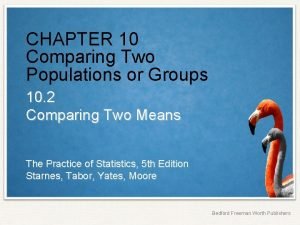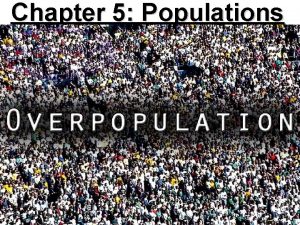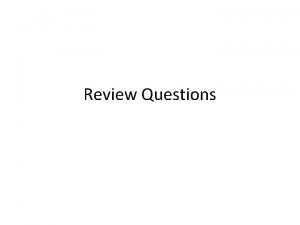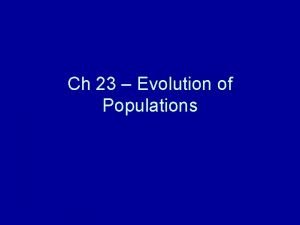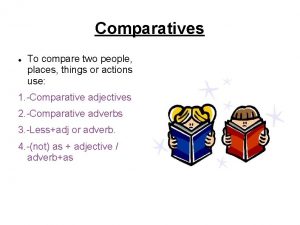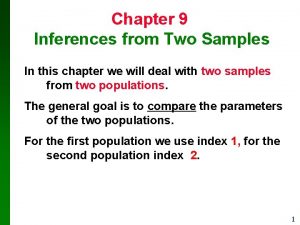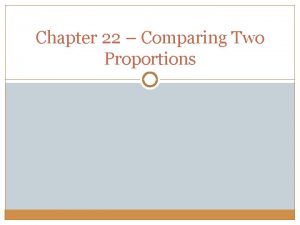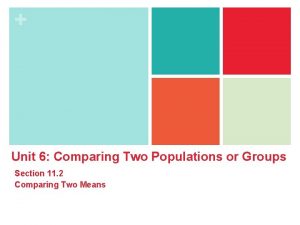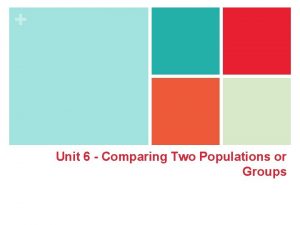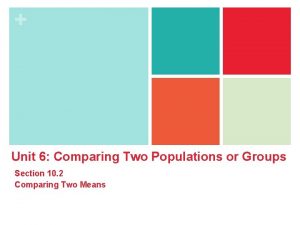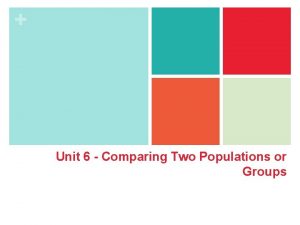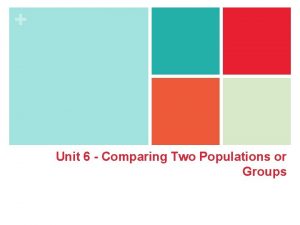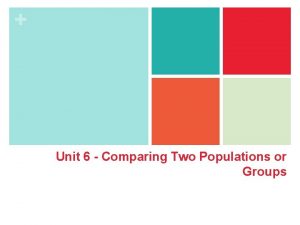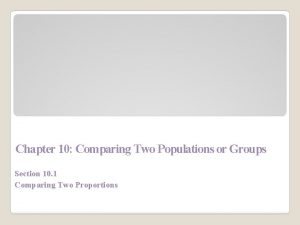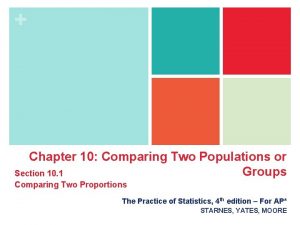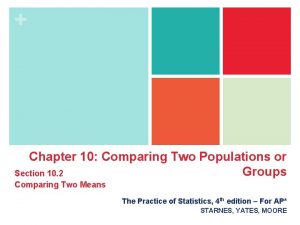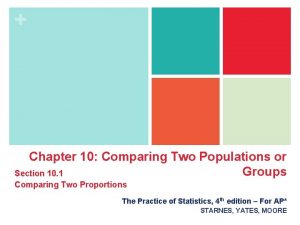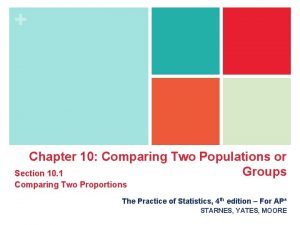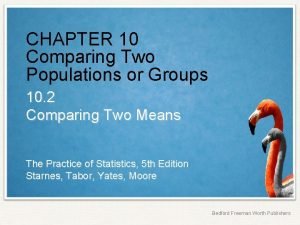Unit 6 Comparing Two Populations or Groups Section
















- Slides: 16

+ Unit 6: Comparing Two Populations or Groups Section 11. 2 Comparing Two Means

+ Unit 6 Comparing Two Populations or Groups n 12. 2 Comparing Two Proportions n 11. 2 Comparing Two Means

+ Section 11. 2 Comparing Two Means Learning Objectives After this section, you should be able to… ü PERFORM a significance test to compare two means ü INTERPRET the results of inference procedures

Tests for µ 1 – µ 2 The alternative hypothesis says what kind of difference we expect. Ha: µ 1 - µ 2 > 0, Ha: µ 1 - µ 2 < 0, or Ha: µ 1 - µ 2 ≠ 0 If the Random, Normal, and Independent conditions are met, we can proceed with calculations. Comparing Two Means An observed difference between two sample means can reflect an actual difference in the parameters, or it may just be due to chance variation in random sampling or random assignment. Significance tests help us decide which explanation makes more sense. The null hypothesis has the general form H 0: µ 1 - µ 2 = hypothesized value We’re often interested in situations in which the hypothesized difference is 0. Then the null hypothesis says that there is no difference between the two parameters: H 0: µ 1 - µ 2 = 0 or, alternatively, H 0: µ 1 = µ 2 + n Significance

Tests for µ 1 – µ 2 + n Significance Comparing Two Means To find the P-value, use the t distribution with degrees of freedom given by technology or by the conservative approach (df = smaller of n 1 - 1 and n 2 - 1).

t Test for The Difference Between n Two-Sample t Test for the Difference Between Two Means If the following conditions are met, we can proceed with a twosample t test for the difference between two means: � Comparing Two Means + n Two-Sample

Calcium and Blood Pressure Comparing Two Means Does increasing the amount of calcium in our diet reduce blood pressure? Examination of a large sample of people revealed a relationship between calcium intake and blood pressure. The relationship was strongest for black men. Such observational studies do not establish causation. Researchers therefore designed a randomized comparative experiment. The subjects were 21 healthy black men who volunteered to take part in the experiment. They were randomly assigned to two groups: 10 of the men received a calcium supplement for 12 weeks, while the control group of 11 men received a placebo pill that looked identical. The experiment was double-blind. The response variable is the decrease in systolic (top number) blood pressure for a subject after 12 weeks, in millimeters of mercury. An increase appears as a negative response Here are the data: + n Example: State: We want to perform a test of H 0 : µ 1 - µ 2 = 0 Ha : µ 1 - µ 2 > 0 where µ 1 = the true mean decrease in systolic blood pressure for healthy black men like the ones in this study who take a calcium supplement, and µ 2 = the true mean decrease in systolic blood pressure for healthy black men like the ones in this study who take a placebo. We will use α = 0. 05.

Calcium and Blood Pressure • Random The 21 subjects were randomly assigned to the two treatments. • Normal With such small sample sizes, we need to examine the data to see if it’s reasonable to believe that the actual distributions of differences in blood pressure when taking calcium or placebo are Normal. Hand sketches of calculator boxplots and Normal probability plots for these data are below: The boxplots show no clear evidence of skewness and no outliers. The Normal probability plot of the placebo group’s responses looks very linear, while the Normal probability plot of the calcium group’s responses shows some slight curvature. With no outliers or clear skewness, the t procedures should be pretty accurate. • Independent Due to the random assignment, these two groups of men can be viewed as independent. Individual observations in each group should also be independent: knowing one subject’s change in blood pressure gives no information about another subject’s response. Comparing Two Means Plan: If conditions are met, we will carry out a two-sample t test for µ 1 - µ 2. + n Example:

Calcium and Blood Pressure P-value Using the conservative df = 10 – 1 = 9, we can use Table B to show that the P-value is between 0. 05 and 0. 10. Comparing Two Means Do: Since the conditions are satisfied, we can perform a two-sample t test for the difference µ 1 – µ 2. + n Example: Conclude: Because the P-value is greater than α = 0. 05, we fail to reject H 0. The experiment provides some evidence that calcium reduces blood pressure, but the evidence is not convincing enough to conclude that calcium reduces blood pressure more than a placebo.

Calcium and Blood Pressure With df = 9, the critical value for a 90% confidence interval is t* = 1. 833. The interval is: Comparing Two Means We can estimate the difference in the true mean decrease in blood pressure for the calcium and placebo treatments using a two-sample t interval for µ 1 - µ 2. To get results that are consistent with the one-tailed test at α = 0. 05 from the example, we’ll use a 90% confidence level. The conditions for constructing a confidence interval are the same as the ones that we checked in the example before performing the two-sample t test. + n Example: We are 90% confident that the interval from -0. 754 to 11. 300 captures the difference in true mean blood pressure reduction on calcium over a placebo. Because the 90% confidence interval includes 0 as a plausible value for the difference, we cannot reject H 0: µ 1 - µ 2 = 0 against the two-sided alternative at the α = 0. 10 significance level or against the one-sided alternative at the α = 0. 05 significance level.

Two-Sample t Procedures Wisely Using the Two-Sample t Procedures: The Normal Condition • Sample size less than 15: Use two-sample t procedures if the data in both samples/groups appear close to Normal (roughly symmetric, single peak, no outliers). If the data are clearly skewed or if outliers are present, do not use t. • Sample size at least 15: Two-sample t procedures can be used except in the presence of outliers or strong skewness. • Large samples: The two-sample t procedures can be used even for clearly skewed distributions when both samples/groups are large, roughly n ≥ 30. Comparing Two Means The two-sample t procedures are more robust against non-Normality than the one-sample t methods. When the sizes of the two samples are equal and the two populations being compared have distributions with similar shapes, probability values from the t table are quite accurate for a broad range of distributions when the sample sizes are as small as n 1 = n 2 = 5. + n Using

Two-Sample t Procedures Wisely ü In planning a two-sample study, choose equal sample sizes if you can. ü Do not use “pooled” two-sample t procedures! ü We are safe using two-sample t procedures for comparing two means in a randomized experiment. ü Do not use two-sample t procedures on paired data! ü Beware of making inferences in the absence of randomization. The results may not be generalized to the larger population of interest. Comparing Two Means Here are several cautions and considerations to make when using twosample t procedures. + n Using

+ Section 11. 2 Comparing Two Means Summary ü Since we almost never know the population standard deviations in practice, we use the two-sample t statistic ü where t has approximately a t distribution with degrees of freedom found by technology or by the conservative approach of using the smaller of n 1 – 1 and n 2 – 1. ü The conditions for two-sample t procedures are:

+ Section 11. 2 Comparing Two Means Summary ü To test H 0: µ 1 - µ 2 = hypothesized value, use a two-sample t test for µ 1 - µ 2. The test statistic is P-values are calculated using the t distribution with degrees of freedom from either technology or the conservative approach.

+ Section 11. 2 Comparing Two Means Summary ü The two-sample t procedures are quite robust against departures from Normality, especially when both sample/group sizes are large. ü Inference about the difference µ 1 - µ 2 in the effectiveness of two treatments in a completely randomized experiment is based on the randomization distribution of the difference between sample means. When the Random, Normal, and Independent conditions are met, our usual inference procedures based on the sampling distribution of the difference between sample means will be approximately correct. ü Don’t use two-sample t procedures to compare means for paired data.

+ Homework: Chapter 11, #’s 40 b, 41 a, 42 a, 43, 47 a&b
 Chapter 10 comparing two populations or groups crossword
Chapter 10 comparing two populations or groups crossword Chapter 10 comparing two populations or groups
Chapter 10 comparing two populations or groups Evolution of populations section 16-1 genes and variation
Evolution of populations section 16-1 genes and variation Section 19-1 understanding populations answer key
Section 19-1 understanding populations answer key Population growth concept map answers
Population growth concept map answers Evolution of populations section 16-1 genes and variation
Evolution of populations section 16-1 genes and variation Evolution of populations section 11 review
Evolution of populations section 11 review 5.1 how populations grow
5.1 how populations grow Section 5-1 how populations grow
Section 5-1 how populations grow A biologist discovers two populations of wolf spiders
A biologist discovers two populations of wolf spiders Smallest unit of evolution
Smallest unit of evolution How are ethnic groups and religious groups related
How are ethnic groups and religious groups related Whats the definition of simile
Whats the definition of simile Comparison of two dissimilar things
Comparison of two dissimilar things Comparing 2 people
Comparing 2 people Comparing two population variances
Comparing two population variances Chapter 22 comparing two proportions
Chapter 22 comparing two proportions

